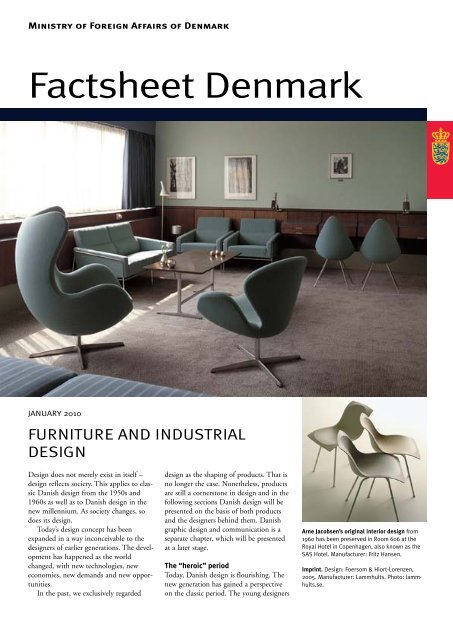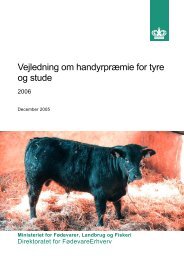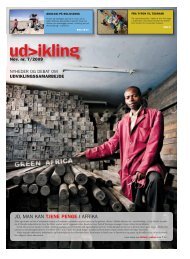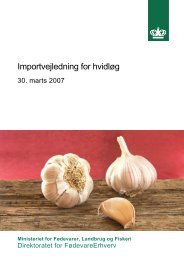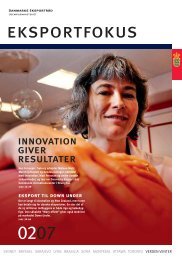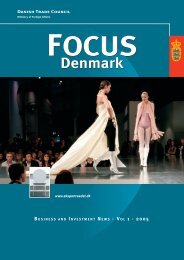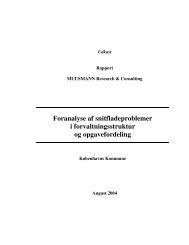Factsheet Denmark Danish Design
Factsheet Denmark Danish Design
Factsheet Denmark Danish Design
You also want an ePaper? Increase the reach of your titles
YUMPU automatically turns print PDFs into web optimized ePapers that Google loves.
Ministry of Foreign Affairs of <strong>Denmark</strong><br />
<strong>Factsheet</strong> <strong>Denmark</strong><br />
JANUARY 2010<br />
FURNITURE AND INDUSTRIAL<br />
DESIGN<br />
<strong>Design</strong> does not merely exist in itself –<br />
design reflects society. This applies to classic<br />
<strong>Danish</strong> design from the 1950s and<br />
1960s as well as to <strong>Danish</strong> design in the<br />
new millennium. As society changes, so<br />
does its design.<br />
Today’s design concept has been<br />
expanded in a way inconceivable to the<br />
designers of earlier generations. The development<br />
has happened as the world<br />
changed, with new technologies, new<br />
economies, new demands and new opportunities.<br />
In the past, we exclusively regarded<br />
design as the shaping of products. That is<br />
no longer the case. Nonetheless, products<br />
are still a cornerstone in design and in the<br />
following sections <strong>Danish</strong> design will be<br />
presented on the basis of both products<br />
and the designers behind them. <strong>Danish</strong><br />
graphic design and communication is a<br />
separate chapter, which will be presented<br />
at a later stage.<br />
The “heroic” period<br />
Today, <strong>Danish</strong> design is flourishing. The<br />
new generation has gained a perspective<br />
on the classic period. The young designers<br />
Arne Jacobsen’s original interior design from<br />
1960 has been preserved in Room 606 at the<br />
Royal Hotel in Copenhagen, also known as the<br />
SAS Hotel. Manufacturer: Fritz Hansen.<br />
Imprint. <strong>Design</strong>: Foersom & Hiort-Lorenzen,<br />
2005. Manufacturer: Lammhults. Photo: lammhults.se.
Public design: Everything we encounter in the<br />
public space as citizens and users is characterised<br />
by design. In the last 20-25 years,<br />
<strong>Denmark</strong> has created public design at an international<br />
level within several fields – especially<br />
the transport sector. But public design is much<br />
broader: For instance, how is the urban space<br />
furnished? How do we experience street and<br />
road lighting? Does the signage at our hospitals<br />
regard the pioneers with respect – but are<br />
able to stand on their own feet.<br />
A presentation of <strong>Danish</strong> design has to<br />
start with its breakthrough on the international<br />
scene after World War II. A fortunate<br />
combination of internal and external<br />
circumstances led to a Golden Age, in<br />
which <strong>Danish</strong> furniture achieved particular<br />
success, but silver, ceramics, glass and<br />
textiles also experienced a fertile period.<br />
A breakthrough such as the classic<br />
<strong>Danish</strong> one can only occur if the talent is<br />
available. And it was! However, talent is<br />
not enough – special growth conditions<br />
are required for the talent to thrive and<br />
develop.<br />
Three circumstances were particularly<br />
crucial to the success of <strong>Danish</strong> design in<br />
the post-war period. The first was the late<br />
industrialisation of <strong>Denmark</strong>. A living<br />
craft tradition with high quality standards<br />
was allowed to develop slowly and gradu-<br />
2<br />
show the way? Is the letter from the local council<br />
easy to understand? Copenhagen Port Pools<br />
from 2002 with the distinctive lifeguard tower is<br />
a good example of what untraditional thinking<br />
and good design can do for the city’s residents.<br />
Photo: Lars Amelang.<br />
PH Artichoke. <strong>Design</strong>: Poul Henningsen, 1958.<br />
Manufacturer: Louis Poulsen.<br />
ally into industrial production, closely<br />
monitored by the architects and master<br />
cabinet makers of the time.<br />
The second was the world’s desire to<br />
see and experience something new after a<br />
war which had left large parts of Europe<br />
in ruins. The <strong>Danish</strong> light wood furniture<br />
with references to Nordic nature and a<br />
look that was sometimes based on classic<br />
furniture types but without the style elements<br />
of former periods soon gained a<br />
foothold internationally.<br />
Thirdly, <strong>Danish</strong> design had room for<br />
the individualists. This trend began to<br />
emerge in the 1930s, when the architect<br />
and critic Poul Henningsen scrutinised<br />
society and agitated for freedom, respect<br />
for the individual and a democratic,<br />
humanist view of life, which was rather<br />
unusual in the Nordic countries at the<br />
time. These attitudes gradually became<br />
widely accepted in <strong>Denmark</strong>.<br />
The soil had thus been fertilised when<br />
the major talents appeared. The talents<br />
were so to speak given a free rein and<br />
architects and furniture designers found<br />
enthusiastic collaborators among master<br />
cabinet makers and other small production<br />
companies.<br />
The establishment of the Furniture<br />
School at the Royal <strong>Danish</strong> Academy of<br />
Fine Arts played a considerable part in the<br />
development of furniture design. Here<br />
Professor Kaare Klint represented Functionalism<br />
with studies of the proportions<br />
between people and objects. Klint has had<br />
greater influence on <strong>Danish</strong> furniture<br />
design than any other designer. His views<br />
of the form and function of furniture have<br />
influenced several generations of <strong>Danish</strong><br />
CH 07. <strong>Design</strong>: Hans J. Wegner, 1963.<br />
Manufacturer: Carl Hansen & Søn. Photo:<br />
larsenform.com.
designers and continue to do so today.<br />
Nonetheless, the Danes remained<br />
slightly sceptical about Functionalism,<br />
which therefore never had a complete<br />
breakthrough. Hans J. Wegner respected<br />
the Klint approach, but struck out a path<br />
for himself. Like several other furniture<br />
designers at the time, Wegner trained as a<br />
cabinet maker and combined extraordinary<br />
craftsmanship with a unique sense of<br />
form, resulting in a series of chairs which<br />
many regard as unsurpassable.<br />
As the head of the cooperative FDB<br />
furniture design studio, Børge Mogensen<br />
designed a furniture series aimed at the<br />
average <strong>Danish</strong> family. It was simple and<br />
robust, and could be combined according<br />
to the family’s needs. In addition, Mogensen<br />
designed several characteristic chairs<br />
which are still in production, including<br />
the Spanish Chair.<br />
Another individualist was Finn Juhl,<br />
Urban furniture: The public space needs many<br />
different kinds of furniture: Benches, advertising<br />
pillars, rubbish bins, street lighting, parking<br />
metres – to mention a few. The individual element<br />
has to meet extensive requirements as do<br />
maintenance and protection against vandalism<br />
and theft. It is a challenge to place each element<br />
where it is needed and combine the layout with<br />
the technical standards applying to the public<br />
who represented the artistic freedom with<br />
a personal idiom and chairs which were at<br />
once harmonious sculptures and traditional<br />
seating furniture.<br />
Concurrently, industrialised furniture<br />
manufacturing developed in the USA,<br />
where the best-known products were<br />
Charles Eames’s chairs of moulded wood<br />
and steel pipes. Eames’s chairs inspired<br />
Arne Jacobsen to design the now worldfamous<br />
Ant chair of bent, laminated<br />
wood from 1952 – <strong>Denmark</strong>’s first example<br />
of an industrially manufactured chair<br />
in the true sense of the word and fully in<br />
line with what the international furniture<br />
trend was producing. Arne Jacobsen was<br />
already recognised as an architect, especially<br />
abroad, but now he became equally<br />
famous as a furniture designer.<br />
<strong>Danish</strong> design aroused an immediate<br />
response in the international press –<br />
among other things due to the large<br />
space. The public bench is a popular design<br />
object. City Bench, designed by Nanna Ditzel.<br />
Photo: The Dzine Partnership.<br />
Scandinavian design exhibitions which<br />
toured the world.<br />
Poul Kjærholm, Verner Panton and<br />
Nanna Ditzel were other designers –<br />
slightly younger than the post-war masters<br />
– who made a strong impression in the<br />
following years.<br />
Unlike other <strong>Danish</strong> designers, Poul<br />
Kjærholm chose to work mainly in steel<br />
and leather. Kjærholm was inspired by the<br />
international style and worked with an<br />
uncompromising perfectionism, which<br />
has made him one of the leading <strong>Danish</strong><br />
furniture designers in recent time.<br />
However, no other designer has been<br />
more imaginative or different than Verner<br />
Panton – today a role model for many<br />
young designers. Panton found little<br />
understanding of his ideas in the <strong>Danish</strong><br />
design environment of his time. He<br />
therefore left <strong>Denmark</strong> and became an<br />
influential designer in 1960s Europe.<br />
Chieftain Chair. <strong>Design</strong>: Finn Juhl, 1949.<br />
Manufacturer: Hansen & Sørensen. Photo: onecollection.com.<br />
PK 22. <strong>Design</strong>: Poul Kjærholm, 1956.<br />
Manufacturer: Fritz Hansen.<br />
Spanish Chair. <strong>Design</strong>: Børge Mogensen, 1958.<br />
Manufacturer: Fredericia Furniture.<br />
Ant Chair. <strong>Design</strong>: Arne Jacobsen, 1952.<br />
Manufacturer: Fritz Hansen. Photo: arne-jacobsen.com.<br />
Panton Chair. <strong>Design</strong>: Verner Panton, 1967.<br />
Manufacturer: Vitra. Photo: paustian.com.<br />
3
Urban open spaces: Marketplaces, squares and<br />
parks – the urban open spaces – play an important<br />
part in all cities. In the old days, the marketplace<br />
was the town’s trading centre, where people<br />
met to buy, sell and hear the latest news.<br />
Today, almost all trading has moved indoors, but<br />
the marketplace and square remain just as<br />
important. The open spaces serve as much<br />
needed breathing spaces for the citizens – used<br />
4<br />
3PART (established 1998) is one of the younger<br />
generation’s leading design companies. Works strategically<br />
with user-driven industrial design.<br />
Mathias Bengtsson (born 1971), designer, has broken<br />
with the <strong>Danish</strong> design tradition. Experiments<br />
with new technologies and materials with originality<br />
and exceptional talent.<br />
Bernt (born 1937), furniture designer, takes the<br />
<strong>Danish</strong> Functionalist tradition as his starting point<br />
with an analytic approach. Has created a number of<br />
distinctive design exhibitions as well as furniture.<br />
Christian Bjørn (born 1944), industrial designer, is a<br />
pioneer within <strong>Danish</strong> industrial design. His work<br />
includes large systems and projects within transport<br />
design, but also smaller, consumer-oriented products.<br />
Louise Campbell (born 1970), industrial designer, is<br />
one of the finest innovators of <strong>Danish</strong> furniture<br />
design. Blazes her own trail and experiments with<br />
free, unconstrained forms and innovative material<br />
choices.<br />
CBD (established 1974) is a multi-disciplinary industrial<br />
design company with international focus. Was<br />
one of the first to look towards Asia and has offices<br />
in China and Vietnam.<br />
<strong>Design</strong>it (established 1991) is currently the largest<br />
design company in <strong>Denmark</strong>. Works with focus on<br />
overall solutions and is frequently involved in the<br />
<strong>Danish</strong> design debate.<br />
Nanna Ditzel (1923-2005), designer, experimented<br />
with new technologies and innovative room installations<br />
at an early stage. Has created a range of furniture<br />
in an organic idiom as well as jewellery and textiles.<br />
Susse Fischer (born 1949), architect, works on the<br />
borderline between design and architecture with<br />
products and major projects reflecting an unerring<br />
balance between aesthetics and functionality.<br />
either as an oasis or as a setting for community<br />
events. The furniture can be magnificent or modest,<br />
but two elements are essential: Somewhere<br />
to sit – in the shadow of a tree. An open space<br />
can also be established in a park. Photo: Tine<br />
Harden.<br />
Who is who in <strong>Danish</strong> furniture and industrial design?<br />
Photo: Anders Sune Berg Photo: christianbjorn.dk Photo: berntmaa.dk<br />
Photo: bengtssondesign.com Photo: 3part.dk<br />
Photo: cbd.dk<br />
Photo: designit.com<br />
Photo: nanna-ditzel-design.dk<br />
Photo: Ture Andersen<br />
Photo: louispoulsen.dk Photo: knudholscher.dk Photo: louispoulsen.dk Photo: foersom-hiort-lorenzen.dk Photo: flindtdesign.dk<br />
Photo: georgjensen.com<br />
Photo: jacob-jensen-design.dk<br />
Photo: royalcopenhagen.com<br />
Photo: onecollection.com<br />
Christian Flindt (born 1972), furniture designer,<br />
belongs to the avantgarde in today’s young <strong>Danish</strong><br />
furniture design. Challenges the traditional idiom and<br />
creates furniture with a dramatic and original look.<br />
Foersom & Hiort-Lorenzen (established 1977) is a 30year<br />
old collaboration, which has resulted in a series<br />
of cogent furniture, worked out to the smallest detail.<br />
Focuses on sustainability and prioritises experiments<br />
and new materials.<br />
Poul Henningsen (1894-1967), architect, made his<br />
mark with his first mass-produced lamp, PH 5/5, in<br />
1926. <strong>Design</strong>ed a number of special lighting systems<br />
for large buildings, all based on his innovative theories<br />
about perception and lighting.<br />
Knud Holscher (born 1930), architect, produces<br />
design solutions characterised by functionality and<br />
simplification of often complex products. Has many<br />
international companies among his customers.<br />
Arne Jacobsen (1902-1971), architect, represented<br />
Modernism and imbued his buildings and other<br />
works with great originality and an idiom which soon<br />
placed him in the international design elite.<br />
Georg Jensen (1866-1935), silversmith, established a<br />
modest silversmith’s workshop in Copenhagen in<br />
1904, which soon became a focus for the most important<br />
artists of the time. Was described as the finest silver<br />
artist in the world for three centuries when he died.<br />
Jacob Jensen (born 1926), industrial designer, created<br />
a series of innovative products for Bang & Olufsen,<br />
which launched a new era within international hi-fi<br />
production and today are found in museums all over<br />
the world.<br />
Ole Jensen (born 1958), designer, experiments with<br />
new materials in a personal idiom. Has created many<br />
innovative articles for everyday use.<br />
Finn Juhl (1912-1989), furniture architect, is one of the<br />
most highly regarded <strong>Danish</strong> furniture architects in an<br />
international perspective. His furniture is characterised<br />
by its sculptural and curved forms, very different<br />
from <strong>Danish</strong> Functionalism.
Photo: stelton.com Photo: bang-olufsen.com Photo: georgjensen.com Photo: komplot.dk<br />
Photo: fritzhansen.com<br />
Photo: lightyears.dk<br />
Photo: royalcopenhagen.dk<br />
Photo: fredericia.com<br />
Photo: royalcopenhagen.com<br />
Poul Kjærholm (1929-1980), furniture architect, was<br />
inspired by the Bauhaus school, but went beyond it.<br />
Has left behind pieces of furniture that are landmarks<br />
in the history of <strong>Danish</strong> furniture design, made of steel,<br />
marble, glass, leather and, in his later years, wood.<br />
Komplot (established 1987) is a design company with<br />
an international outlook, which especially in recent<br />
years has experimented with a new idiom and new<br />
materials in its furniture design.<br />
Henning Koppel (1918-1981), sculptor, began working<br />
for Georg Jensen in 1945 and with his both simple<br />
and bold forms launched a new epoch within <strong>Danish</strong><br />
silver. Has also designed porcelain for Bing & Grøndahl.<br />
David Lewis (born 1939), industrial designer, in his<br />
capacity of chief designer for Bang & Olufsen and in<br />
his collaborations with other international companies,<br />
has created a union of function and aesthetics,<br />
which has resulted in many prestigious design awards.<br />
Erik Magnussen (born 1940), industrial designer, is<br />
one of <strong>Denmark</strong>’s most important designers, whose<br />
products are always based on an original idea and<br />
characterised by a strict, minimalist idiom combined<br />
with functionality and user-friendliness.<br />
Cecilie Manz (born 1972), industrial designer, is one<br />
of the leading figures in contemporary <strong>Danish</strong><br />
designs. Extends the understanding of the function<br />
and aesthetics of design and challenges established<br />
concepts of what design can and should do.<br />
Grethe Meyer (1918-2008), architect, has created<br />
some of the best-known classics of <strong>Danish</strong> design on<br />
the basis of scientific analyses and with an infallible<br />
sense of form, for companies such as Royal Copenhagen<br />
and Georg Jensen.<br />
Børge Mogensen (1914-1972), furniture architect,<br />
headed the cooperative FDB in 1942-1950. Belonged<br />
to the Golden Age of <strong>Danish</strong> design and further<br />
developed a number of well-known international furniture<br />
types with great success.<br />
Ursula Munch-Petersen (born 1937), designer, works<br />
with one-off objects and sculptural ceramics. Has<br />
developed functional articles for everyday use, with<br />
new techniques and materials, most recently the<br />
popular Ursula service for Royal Copenhagen.<br />
Visual identity: Visual identity is a means of<br />
highlighting and controlling the values governing<br />
a company. For what does the company want<br />
to be known? Which signals does it want to send<br />
to its surroundings? The business world has a<br />
long tradition of using graphic design to communicate<br />
and profile itself. The public sector has<br />
learned from the private sector. Most public<br />
institutions today have a visual identity and a<br />
Photo: fritzhansen.com Photo: Christian Petersen Photo: pelikan.dk<br />
Photo: louispoulsen.dk Photo: Torsten Graae<br />
Photo: anders-smith.com<br />
Photo: strand-hvass.com<br />
Photo: Unknown<br />
Photo: fritzhansen.com<br />
design programme as part of their communication<br />
with the citizens and the rest of the world.<br />
Photo: The visual identity of the <strong>Danish</strong> Ministry<br />
of Foreign Affairs, designed by Kontrapunkt.<br />
Ole Palsby (born 1935), designer, transfers userfriendliness<br />
from the professional kitchen to the<br />
home through studies of form and function. Has<br />
designed products of international format.<br />
Verner Panton (1926-1998), architect, is the leading<br />
showman of <strong>Danish</strong> design. Internationally famous<br />
and recognised for his original and experimental furniture,<br />
lighting and revolutionary interior decoration.<br />
Pelikan <strong>Design</strong> (established 1978) had an international<br />
outlook at an early stage and is today a leading<br />
industrial design company, focusing especially on furniture<br />
design.<br />
Søren Ulrik Petersen (born 1961), furniture designer,<br />
takes the classic <strong>Danish</strong> furniture tradition as his<br />
starting point and combines humour and originality<br />
with a practical and functional approach.<br />
Kasper Salto (born 1967), furniture designer, belongs<br />
to the new generation of <strong>Danish</strong> furniture designers.<br />
Builds on <strong>Danish</strong> furniture design heritage with works<br />
set to become <strong>Danish</strong> classics of the future.<br />
Anders Smith (born 1962), industrial designer, was<br />
internationally oriented at an early stage with several<br />
years’ residence abroad as design manager for<br />
Philips. Now works in Copenhagen, focusing on<br />
strategic consultancy and user-focused design.<br />
Strand+Hvass (established 1998) prioritise experiments<br />
with forms and materials, resulting in solutions<br />
and products that surprise and renew the <strong>Danish</strong><br />
furniture tradition.<br />
Jan Trägårdh (1931-2006), industrial designer, has<br />
been very important to the development of industrial<br />
design in <strong>Denmark</strong>. Has designed many pioneering<br />
industrial products, using Functionalism as his starting<br />
point.<br />
Hans J. Wegner (1914-2007), furniture architect, is<br />
probably the best known of all <strong>Danish</strong> furniture architects.<br />
He was especially important as the chair<br />
designer par excellence and designed many of the<br />
most beautiful and original chairs in the world.<br />
5
Urban floor: The floor is an element of the urban<br />
space which is often overlooked. Chance and<br />
short-term financial considerations have often<br />
been allowed to determine the nature of the surface.<br />
However, the urban floor should have a<br />
function and help clarify traffic flows to both<br />
pedestrians and drivers besides having an architectonic<br />
effect. The ideal surface is based on<br />
variation of materials, textures, patterns and<br />
Trinidad. <strong>Design</strong>: Nanna Ditzel, 1993.<br />
Manufacturer: Fredericia Furniture. Photo:<br />
nanna-ditzel-design.dk.<br />
Polyether chair. <strong>Design</strong>: Gunnar Aagaard<br />
Andersen, 1964. Photo: Pernille Klemp.<br />
X-line. <strong>Design</strong>: Niels Jørgen Haugesen, 1977.<br />
Manufacturer: Bent Krogh. – This award-winning<br />
chair is the closest <strong>Danish</strong> design gets to High<br />
Tech. Photo: bent-krogh.dk.<br />
Inspired by among others Verner<br />
Panton, Nanna Ditzel started her long<br />
career in the 1950s with bold and colourful<br />
complete environments and new ways<br />
of living. After several years in England,<br />
Nanna Ditzel returned to <strong>Denmark</strong> in<br />
1986 and in the following years created<br />
furniture with a strong personal look,<br />
which have helped renew <strong>Danish</strong> furniture<br />
design.<br />
Among the designers of the time,<br />
Gunnar Aagaard Andersen had a special<br />
position. He was the artist and<br />
Renaissance man, who as a designer was<br />
primarily known for his polyether chair<br />
from 1964, whose extreme look has<br />
inspired today’s young <strong>Danish</strong> designers.<br />
<strong>Danish</strong> furniture design 1970-1980<br />
<strong>Danish</strong> furniture design struggled to<br />
6<br />
colours. The urban floor can be a work of art,<br />
like Amagertorv in Copenhagen created by the<br />
artist Bjørn Nørgaard. However, less will do, as<br />
long as attention is paid to the context and the<br />
connection with the surrounding buildings and<br />
open spaces. Photo: Troels Heien.<br />
maintain its leading position in the 1970s<br />
and 1980s. The world had changed.<br />
Industrialisation had taken hold and was<br />
expanding rapidly. Light <strong>Danish</strong> and<br />
Scandinavian design had many followers,<br />
but many others called for something that<br />
was more in keeping with the times and<br />
with the suddenly exploding youth culture.<br />
The international design scene was<br />
characterised by fierce competition and<br />
activity – especially within furniture<br />
design. In the 1980s, Post-Modernism<br />
was introduced and, in parallel, the<br />
Memphis movement in Milan. Slightly<br />
later, the High Tech style and other trends<br />
followed. <strong>Danish</strong> restraint and focus on<br />
function therefore struggled in the international<br />
competition. A few <strong>Danish</strong><br />
designers hesitantly attempted the new<br />
trends, but most found it difficult to<br />
either develop their heritage or liberate<br />
themselves from it.<br />
<strong>Danish</strong> furniture design therefore experienced<br />
little renewal in these years and<br />
manufacturers and producers likewise<br />
showed little response to or interest in<br />
experimentation. The talents of the time<br />
were relatively isolated compared with the<br />
fertile climate surrounding the pioneers in<br />
the 1950s.<br />
Industrial design<br />
<strong>Danish</strong> furniture design may have had a<br />
relatively quiet time in the 1970s and<br />
1980s but industrial design, by contrast,<br />
was very active.<br />
Concurrently with the international<br />
industrialisation, the first industrial design<br />
trends appeared in Europe and the USA.<br />
In Germany, the Bauhaus school was<br />
established in 1919, combining art and<br />
technology with functionality and a simple<br />
idiom. In the early 1940s, a kind of<br />
streamlined Modernism emerged in the<br />
USA. Here design had to be spectacular<br />
–“styling” had to seduce and tempt people<br />
to buy.<br />
Margrethe Bowl. <strong>Design</strong>: Bernadotte & Bjørn<br />
Industridesign, 1950. Manufacturer: Rosti.<br />
Photo: rosti-housewares.dk
Thermo. <strong>Design</strong>: Erik Magnussen, 1976.<br />
Manufacturer: Stelton.<br />
Beogram 4000. <strong>Design</strong>: Jacob Jensen, 1974.<br />
Manufacturer: Bang & Olufsen. Photo: Ib<br />
Sørensen.<br />
Beosystem 2500. <strong>Design</strong>: David Lewis, 1991.<br />
Manufacturer: Bang & Olufsen. Photo: Ib<br />
Sørensen.<br />
In <strong>Denmark</strong>, the values which had<br />
characterised the <strong>Danish</strong> post-war furniture<br />
– focus on the user, respect for materials<br />
and attention to details – also became<br />
prevalent within industrial design. It was<br />
natural for the industrial designers to find<br />
inspiration in especially Functionalism<br />
and Bauhaus. However, as already mentioned,<br />
<strong>Danish</strong> Functionalism was “organic”,<br />
which was very different from the often<br />
strict and dogmatic idiom of Bauhaus.<br />
Bernadotte & Bjørn was the first<br />
design studio in <strong>Denmark</strong> and Scandinavia<br />
to specialise in industrial design. The<br />
design studio was established already in<br />
1950 and employed several of the later<br />
most successful <strong>Danish</strong> designers. Among<br />
other things, Bernadotte & Bjørn designed<br />
office machines, domestic appliances, furniture<br />
and other functional articles for<br />
everyday use, with the Margrethe Bowl as<br />
one of the most successful and long-lived.<br />
Urban lighting: Urban lighting forms a significant<br />
part of the urban stage design. The lighting<br />
must not steal from buildings and open spaces,<br />
but has to stage manage and dramatise the city,<br />
create atmosphere and experience. At the same<br />
time, the lighting must help make the city safe<br />
for those who use it after dark. However, there<br />
must be a plan for the use of lighting – for there<br />
are many interested parties. It is an art to light<br />
The number of design studios grew in<br />
parallel with the industrial development<br />
and the emergence of new manufacturing<br />
methods and materials. The success of<br />
<strong>Danish</strong> furniture design inspired a number<br />
of companies to enter into collabora-<br />
the urban space and to combine facade lighting<br />
and atmospheric lighting. Aggressive commercial<br />
lighting frightens the customers away. Used<br />
correctly, lighting helps give the city a special<br />
identity. Photo: tivoli.dk.<br />
tion with industrial designers, including<br />
Bang & Olufsen. In collaboration with<br />
first Bernadotte & Bjørn and later Jacob<br />
Jensen and David Lewis, B&O translated<br />
technological development into superlative<br />
design and entertainment electronics.<br />
7
Signage: Signage is one of the most important<br />
elements of a building’s or city’s furniture.<br />
Signage has many functions, which users take<br />
for granted. Signage must inform, advise, direct,<br />
highlight and at times prohibit. The messages<br />
must be visible, easy to read, and understandable<br />
– complicated messages can constitute a<br />
safety risk. The art is to limit the number of<br />
signs and to place them exactly where they are<br />
Copenhagen. <strong>Design</strong>: Grethe Meyer, 1991.<br />
Manufacturer: Georg Jensen.<br />
Opus carafe. <strong>Design</strong>: Ole Palsby, 2006.<br />
Manufacturer: Rosendahl.<br />
Lemon squeezer. <strong>Design</strong>: Ole Jensen, 1997.<br />
Manufacturer: Royal Copenhagen.<br />
Mussel Mega. <strong>Design</strong>: Karen Kjældgård-Larsen,<br />
2002. Manufacturer: Royal Copenhagen.<br />
– A young designer’s bold enlargement of the<br />
blue fluted service from 1775 has led to international<br />
success.<br />
Ursula. <strong>Design</strong>: Ursula Munch-Petersen, 1992.<br />
Manufacturer: Royal Copenhagen.<br />
Corsinel underwear for stoma patients.<br />
<strong>Design</strong>: Astrid Krogh and Annette Meyer, 2004.<br />
Manufacturer: Coloplast.<br />
NovoLet insulin pen. <strong>Design</strong>: Steve McGugan,<br />
1989. Manufacturer: Novo Nordisk.<br />
Ultrasound scanner. <strong>Design</strong>: Anders Smith,<br />
2004. Manufacturer: Philips.<br />
Microsound Pilot hearing aid. <strong>Design</strong>: <strong>Design</strong>it,<br />
2003. Manufacturer: Microsound.<br />
8<br />
needed. This is particularly true in airports,<br />
where the travellers are especially dependent on<br />
fast and accurate information. The signage in<br />
Copenhagen Airport, designed by Mollerup<br />
<strong>Design</strong>lab. Photo: cph.dk.
The company Stelton followed suit by<br />
establishing collaborations with first Arne<br />
Jacobsen and later Erik Magnussen, whose<br />
vacuum jug broke with all accepted ideas<br />
about the look and function of vacuum<br />
jugs. Today, both Bang & Olufsen’s products<br />
and Erik Magnussen’s vacuum jug<br />
have iconic status internationally.<br />
<strong>Danish</strong> design’s focus on organic<br />
Functionalism is also evident in tableware,<br />
where Grethe Meyer, Ole Palsby, Ursula<br />
Munch-Petersen, Ole Jensen and many<br />
others have renewed the product field.<br />
A special design field is medical technology,<br />
where <strong>Danish</strong> designers in keeping<br />
with tradition focus on the dialogue<br />
with the user. Here young design companies<br />
such as 3PART, <strong>Design</strong>it and CBD<br />
can be mentioned, as well as individual<br />
designers such as Steve McGugan and<br />
Anders Smith.<br />
Overall, industrial design has played a<br />
Transport: In the battle for the train passengers<br />
of the future, comfort and travel time will be<br />
important features. Something extra is required<br />
for public transport to replace private cars as the<br />
preferred means of travel. In the 1990s, the<br />
<strong>Danish</strong> State Railways launched the IC3 train,<br />
which operates the length and breadth of<br />
<strong>Denmark</strong> over bridges and through tunnels. IC3<br />
is a success and will be supplemented with the<br />
significant role in <strong>Danish</strong> industry for the<br />
past fifty years. Many companies which<br />
initially mainly associated design with<br />
homeware soon changed their opinion<br />
and today <strong>Danish</strong> industrial design covers<br />
the entire spectrum of industrially<br />
designed products – from tea spoons via<br />
sophisticated measuring instruments to<br />
ships and train sets.<br />
The recently launched “Index: Award”,<br />
which is awarded biannually for products<br />
and ideas that improve our lives, can be<br />
regarded as a further development of the<br />
user focus of <strong>Danish</strong> design.<br />
<strong>Danish</strong> furniture design today<br />
During the 1990s, something new began<br />
to happen in <strong>Danish</strong> furniture design.<br />
Groups of young designers were established,<br />
presenting a new, expressive, internationally<br />
inspired idiom. Many regarded<br />
these initiatives as ephemeral and found it<br />
new IC4 train in the near future. In 2002, the<br />
Metro introduced a new train type to Copenhagen<br />
– the driver-less METRO train. Photo: A<br />
Metro station in Copenhagen, designed by KHR<br />
Architects.<br />
The Harbour Stage. <strong>Design</strong>: Susse Fischer<br />
and Christian Bjørn, 2005. – One of the world’s<br />
first floating mobile open air stages.<br />
Photo: Mikkel Stenbæk.<br />
d line. <strong>Design</strong>: Knud Holscher, 1972.<br />
Manufacturer: d line international.<br />
Cheetah wheelchair for children. <strong>Design</strong>: 3PART,<br />
2004. Manufacturer: R82.<br />
Flamingo T1. <strong>Design</strong>: Halskov & Dalsgaard, 2005.<br />
Manufacturer: Lightyears. – A combination of<br />
informality and functionalism is characteristic of<br />
much contemporary <strong>Danish</strong> design.<br />
9
Bus stop: The bus stop must help making public<br />
transport attractive. It must have a distinctive<br />
identity so that the traveller can easily spot it<br />
from a distance. It must provide shelter, it must<br />
have a bench – long waits may occur – and easily<br />
accessible information with understandable<br />
messages. Information must be limited to essentials<br />
and not drown in “noise”. Basic requirements,<br />
which many bus stops do not meet.<br />
Veryround. <strong>Design</strong>: Louise Campbell, 2006.<br />
Spun Chaise Lounge. <strong>Design</strong>: Mathias<br />
Bengtsson, 2003.<br />
Parts of a Rainbow. <strong>Design</strong>: Christian Flindt,<br />
2005.<br />
Miss Tilde. <strong>Design</strong>: Gopingpong, 2005. –<br />
Somewhere to keep private memories by a<br />
young radical design studio.<br />
Waves. <strong>Design</strong>: Anne-Mette Jensen and Morten<br />
Ernst, 1994. Manufacturer: Erik Jørgensen. –<br />
<strong>Danish</strong> designers’ play with organic forms.<br />
Plasma. <strong>Design</strong>: Erik Magnussen, 2005.<br />
Manufacturer: Engelbrechts. – Plasma proves<br />
that vision and innovation are not restricted to<br />
the new generation of <strong>Danish</strong> designers.<br />
10<br />
Some do. Photo: Movia’s bus stop in Copenhagen,<br />
designed by Knud Holscher <strong>Design</strong>.<br />
difficult to take them seriously, calling for<br />
more direct successors to the classic<br />
<strong>Danish</strong> design.<br />
However, the experiments and the new<br />
design were there to stay. The groups<br />
paved the way for today’s <strong>Danish</strong> designers,<br />
who have successfully either developed<br />
or broken with the traditional<br />
<strong>Danish</strong> design idiom.<br />
Simply put, there are today two trends<br />
within the new generation of <strong>Danish</strong> furniture<br />
designers and industrial designers.<br />
One is “wild” with pioneering design and<br />
an informal idiom using spectacular and<br />
sculptural forms. It is represented by<br />
designers such as Louise Campbell, Mathias<br />
Bengtsson, Christian Flindt, Sebastian<br />
Holmbäck and the Gopingpong<br />
group.<br />
The other is “disciplined”, with a clear<br />
basis in the <strong>Danish</strong> design tradition in its<br />
respect for classic craft, yet sufficiently
old to experiment with new technology<br />
and new materials. It is represented by<br />
designers such as Søren Ulrik Petersen,<br />
Cecilie Manz, Kasper Salto, Hans Sandgren<br />
Jakobsen, Christina Strand and Niels<br />
Hvass.<br />
Both trends have given <strong>Danish</strong> design<br />
and especially <strong>Danish</strong> furniture design the<br />
talent and energy in short supply for several<br />
generations.<br />
<strong>Danish</strong> designers are increasingly inter-<br />
Bridges: <strong>Denmark</strong> is characterised by many<br />
waterways, which require a special infrastructure.<br />
Formerly the ferries connected the country.<br />
Today – with the current requirements for fast<br />
traffic flow – bridges have often taken over<br />
this function, among others across the Great<br />
Belt, where the beautiful and distinctive East<br />
Bridge, opened in 1998 and designed by<br />
Dissing+Weitling, has virtually achieved the<br />
ested in sustainable solutions. An example<br />
is the chair Imprint designed by Johannes<br />
Foersom and Peter Hiort-Lorenzen in an<br />
environmentally friendly wood fibre material,<br />
which has set new standards for sustainability<br />
within <strong>Danish</strong> furniture design.<br />
<strong>Danish</strong> design is not a uniform and<br />
unambiguous concept to the same extent<br />
as in the past, but has developed into a far<br />
broader idiom than the famous style icons<br />
from the 1940s and 1950s. The new gen-<br />
status of a national monument.<br />
Photo: Dissing+Weitling.<br />
Mosquito. <strong>Design</strong>: Rud Thygesen, 2000.<br />
Manufacturer: N. Roth Andersen. – A contemporary<br />
idiom by one of the veterans of <strong>Danish</strong><br />
design.<br />
Gallery. <strong>Design</strong>: Hans Sandgren Jakobsen, 1998.<br />
Manufacturer: Fredericia Furniture.<br />
Gubi Chair. <strong>Design</strong>: Komplot, 2004.<br />
Manufacturer: Gubi.<br />
Slow Chair. <strong>Design</strong>: Søren Ulrik Petersen, 2000.<br />
Manufacturer: PP Møbler.<br />
eration has added humour and irony to<br />
the traditional values. The influence of<br />
Functionalism is still seen, but the young<br />
designers are characterised by a great<br />
degree of internationalisation, which contributes<br />
to developing and varying the<br />
special nature of <strong>Danish</strong> design. In addition,<br />
the borderlines between design,<br />
architecture and craft are increasingly<br />
fluid, which will contribute to the development<br />
in the coming years.<br />
11
Furniture and industrial design<br />
<strong>Factsheet</strong> <strong>Denmark</strong>. Published by the Ministry of Foreign Affairs<br />
of <strong>Denmark</strong>.<br />
Adress: Asiatisk Plads 2, DK-1448 Copenhagen K, <strong>Denmark</strong>.<br />
Telephone: +45 33 92 00 00. Fax: +45 32 54 05 33.<br />
E-mail: um@um.dk. Website: www.um.dk<br />
Editor: Flemming Axmark.<br />
Picture editor: Kirstine Fryd.<br />
New times – new concepts<br />
In keeping with the international trends,<br />
there is greater focus on design in<br />
<strong>Denmark</strong> than ever before. Industry is<br />
increasingly thinking strategically and<br />
understanding the importance of design<br />
to the companies’ business development.<br />
A contributory factor is the <strong>Danish</strong> government’s<br />
commitment to design. In the<br />
late 1990s, the <strong>Danish</strong> government was<br />
one of the first in the world to define an<br />
actual design policy – an initiative which<br />
in 2007 was followed up by the launch of<br />
<strong>Design</strong><strong>Denmark</strong> as part of the general<br />
<strong>Danish</strong> trade and industry policy.<br />
At the same time, the design concept<br />
has developed. Service design, interaction<br />
design and concept design are among the<br />
concepts which are placing new demands<br />
on the designers and their ability to collaborate<br />
and form networks with other<br />
professions. As in other industrialised<br />
countries, the <strong>Danish</strong> design profession is<br />
engaged in adapting to and taking part<br />
in this new reality.<br />
Birgitta Capetillo<br />
MA, <strong>Design</strong> Communications<br />
12<br />
Further Information<br />
<strong>Denmark</strong>´s Official Web Site<br />
www.denmark.dk<br />
<strong>Danish</strong> <strong>Design</strong> Centre<br />
H.C. Andersens Boulevard 27<br />
DK-1553 Copenhagen V<br />
Telephone: +45 33 69 33 69<br />
E-mail: design@ddc.dk<br />
Website: www.ddc.dk<br />
Translation: Siri Fischer Hansen.<br />
<strong>Design</strong>: Ole Jensen - ojdesign.<br />
Reproduction of the text, with or without<br />
acknowledgement, is permitted.<br />
Published January 2010.<br />
ISBN 978-87-7087-304-8<br />
<strong>Danish</strong> <strong>Design</strong>ers<br />
Strandgade 27A<br />
DK-1401 Copenhagen K<br />
Telephone: +45 33 13 72 30<br />
E-mail: design@danishdesigners.com<br />
Website: www.danishdesigners.com<br />
4-cast. <strong>Design</strong>: Strand+Hvass, 2006.<br />
Manufacturer: Four <strong>Design</strong>.<br />
Caravaggio. <strong>Design</strong>: Cecilie Manz, 2005.<br />
Manufacturer: Lightyears.<br />
Ice. <strong>Design</strong>: Kasper Salto, 2002.<br />
Manufacturer: Fritz Hansen.


